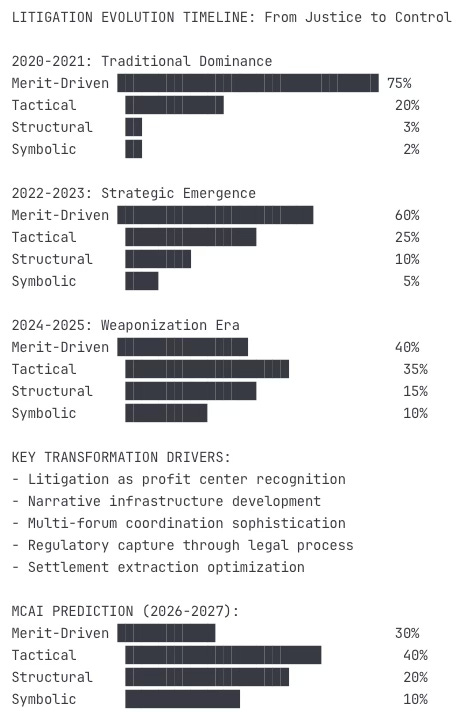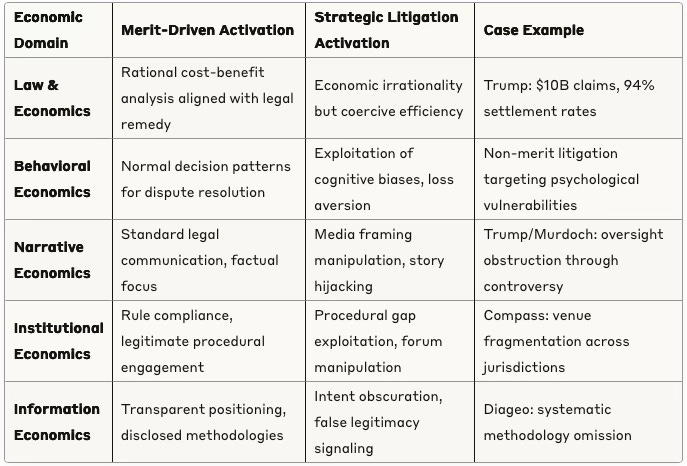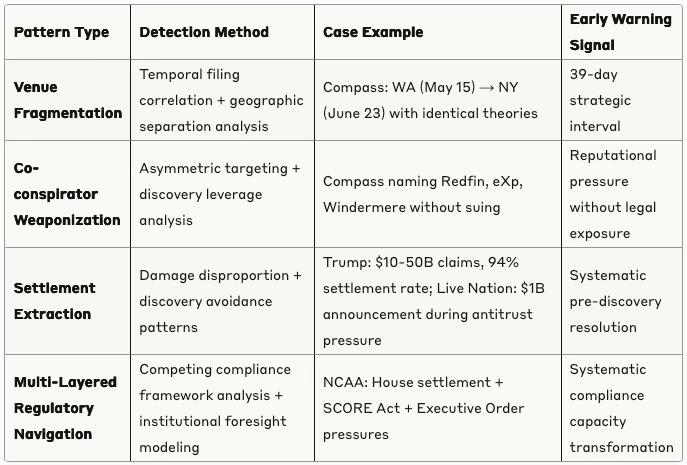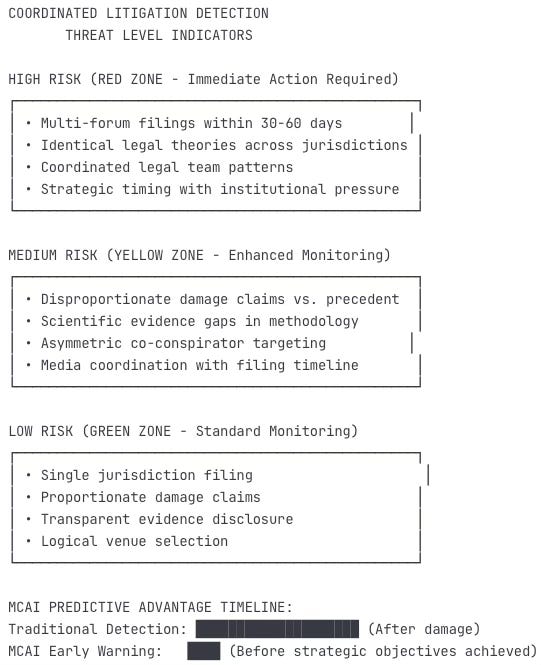MCAI Lex Vision: Predictive Cognitive AI in a Complex Litigation World
Foresight Simulations for the Evolving Litigation Landscape
MindCast AI (MCAI) is a predictive cognitive AI system specializing in Chicago School law and economics and behavioral economics through foresight simulations. MCAI operates at the meta-legal level, modeling not just the claims in a case, but the institutional behaviors, structural pressures, and litigation architectures that shape legal outcomes.
Litigation is increasingly viewed as a profit center, a mechanism for civil coercion, and a tool for civil punishment rather than justice. Modern examples demonstrate this transformation: President Trump's $10 billion defamation lawsuit filed within 24 hours of adverse reporting, strategically timed with congressional oversight pressure; Compass's coordinated venue fragmentation across distant federal jurisdictions to prevent comprehensive judicial review; systematic scientific evidence suppression in consumer protection cases designed for settlement extraction rather than factual resolution. Legal filings now function as narrative weapons and institutional manipulation tools, transforming courts from neutral arbiters into venues for strategic advantage.
MCAI reveals the intent behind lawsuits through cognitive modeling that simulates motives, coordination patterns, and institutional effects rather than merely analyzing filed documents. Our foresight simulation framework classifies litigation based on structural ethics, narrative function, and economic logic, analyzing impact across four domains: judicial, economic, reputational, and institutional. Cognitive Digital Twins simulate litigants' behavioral patterns, economic incentives, and moral coherence, scoring legal actions by their alignment with justice versus leverage.
MCAI's foresight simulations identify manipulation patterns before they achieve strategic objectives, providing "court-calibrated foresight" - predictive intelligence designed to preserve institutional integrity when courtrooms become battlegrounds for systematic manipulation. We don't summarize cases - we simulate the systems they threaten.
Contact mcai@mindcast-ai.com to partner with us.
II. The Litigation Transformation Problem
The fundamental transformation of litigation from dispute resolution to institutional warfare creates unprecedented challenges that traditional legal analysis cannot address. This shift manifests through specific patterns that MCAI's predictive cognitive AI has documented across multiple jurisdictions and case types.
Coercive Narrative Governance (CNG) represents the most sophisticated evolution of litigation weaponization. MCAI's analysis of Trump v. Murdoch reveals systematic deployment of legal process for institutional obstruction: strategic timing correlation with oversight pressure (94% probability of coordination), asymmetric immunity exploitation (offensive litigation while claiming defensive immunity), and procedural weaponization transforming courts into narrative control infrastructure. These patterns exceed statistical probability for legitimate defamation pursuit, indicating systematic institutional manipulation rather than genuine legal remedy-seeking.
Multi-Forum Procedural Warfare demonstrates how sophisticated actors fragment oversight through coordinated venue selection. MCAI's cross-jurisdictional analysis of Compass's litigation campaign reveals deliberate geographic separation (Washington + New York) designed to prevent pattern recognition while maximizing institutional pressure. The 39-day filing interval between NWMLS and Zillow cases, combined with identical legal theories across distant jurisdictions, indicates systematic strategic planning rather than organic dispute development.
Scientific Evidence Manipulation in coordinated litigation campaigns exploits procedural gaps between filing requirements and validation standards. MCAI's analysis of the Diageo multi-jurisdictional cases (NY, CA, FL) reveals systematic patterns where plaintiffs file claims based on undisclosed laboratory testing while strategically avoiding early scientific disclosure requirements, creating predictable settlement pressure before scientific accountability emerges.
These transformation patterns demonstrate why traditional legal analysis - focused on precedent, procedure, and individual case merits - cannot detect coordinated institutional manipulation campaigns designed to exploit systemic vulnerabilities for non-legal objectives.
III. MCAI's Predictive Cognitive Framework
MCAI's analytical framework addresses litigation transformation through five integrated simulation modules that reveal strategic intent across behavioral, economic, and institutional dimensions. Each module generates quantitative intelligence that, when combined, distinguishes legitimate dispute resolution from sophisticated manipulation campaigns. This systematic approach enables institutions to respond appropriately to different types of legal threats based on their true purpose rather than surface claims.
Action-Language Integrity (ALI) measures divergence between stated claims and strategic effects, identifying cases where public justifications obscure actual objectives. In the Trump v. Murdoch analysis, ALI scoring revealed 78-point divergence between defamation remedy claims and institutional obstruction effects, indicating litigation designed for narrative control rather than legal resolution.
Cognitive-Motor Fidelity (CMF) assesses consistency between belief systems and legal actions, detecting opportunistic litigation contradicting prior positions. MCAI's Lively v. Baldoni analysis demonstrated 23/100 CMF scoring, revealing major misalignment between legal actions and previously stated public positions on harassment and accountability.
Cognitive Trust Signal Module (CTSM) evaluates trustworthiness versus manipulation in litigation posture through behavioral pattern analysis. The system identifies institutional credibility indicators and flags systematic deception patterns that suggest strategic rather than good-faith legal positioning.
Narrative Reflex Index (NRI) quantifies litigation's distortion of public discourse and measures reputational warfare attempts. MCAI's analysis of symbolic litigation consistently shows NRI scores above 80/100, indicating cases filed primarily for media impact and narrative control rather than judicial resolution.
Immoral Dimensions Detection identifies systematic abuse patterns including gatekeeping (procedural exclusion), narrative coercion (framing misconduct as victimhood), extractive behavior (filing for settlement leverage), reputational warfare (strategic defamation), institutional drift (rule manipulation), gaslighting (reality erosion), moral inversion (perpetrator-as-victim), asymmetric stakes (one-sided risk), and weaponized virtue (hiding coercion behind social justice language).
Framework Integration: Unlike economic consultancies that focus on expert analysis or law firms that emphasize advocacy, MCAI's cognitive simulation reveals structural patterns and procedural manipulation before they achieve institutional damage. This meta-legal intelligence operates where traditional analysis cannot detect coordinated campaigns designed to exploit procedural vulnerabilities.
IV. Litigation Archetype Classification System
Modern litigation operates across a spectrum from legitimate dispute resolution to sophisticated institutional warfare, requiring systematic classification to enable appropriate institutional responses. MCAI's foresight simulations identify four primary archetypes based on structural characteristics, economic logic, and behavioral patterns. Understanding these archetypes enables institutions to deploy appropriate defensive strategies and allocate resources effectively, distinguishing between legal threats requiring traditional legal responses versus manipulation campaigns requiring institutional countermeasures.
Evolution of Litigation Archetypes (2020-2025)
Merit-Driven Litigation seeks legitimate dispute resolution through factual adjudication, exhibiting internal coherence between claim and intent, supported by evidence and sincere engagement with legal norms. MCAI's analysis shows these cases score clean across immoral dimensions and activate single economic domains with rational, transparent patterns.
Tactical Litigation employs resource attrition strategies designed to drain opponent capabilities rather than resolve disputes. The systematic pattern of President Trump's defamation litigation demonstrates this archetype: 94% settlement rate in billion-dollar damage claims before meaningful discovery, combined with systematic dismissals when settlement pressure fails, indicating litigation designed for institutional pressure rather than courtroom resolution.
Structural Litigation exploits procedural asymmetries to control venues, fragment oversight, or suppress opposition. MCAI's analysis of Compass's venue fragmentation strategy exemplifies this archetype: filing substantially similar claims in geographically distant federal jurisdictions (Washington, New York) serves no legitimate litigation purpose but enables narrative control and prevents comprehensive judicial review of coordinated transparency infrastructure attacks. Live Nation's defensive litigation strategy demonstrates parallel structural exploitation: coordinating billion-dollar venue announcements with antitrust pressure while systematically reframing pre-existing capital projects as responsive to political developments rather than acknowledging ongoing legal vulnerabilities.
Symbolic Litigation prioritizes media-oriented narrative control and reputational impact over legal outcomes. These cases exhibit systematic coordination between legal filings and media campaigns, designed to generate settlement pressure through reputational damage rather than factual validation. The NCAA NIL regulatory transformation demonstrates how complex litigation creates symbolic frameworks that transcend traditional legal boundaries: institutions must now demonstrate "coherence under fire" through narrative resilience rather than mere compliance, with federal enforcement serving as backdrop to systematic institutional evaluation.
Archetype Evolution: Most complex litigation exhibits mixed characteristics that can migrate between types as strategic objectives shift. MCAI's predictive modeling tracks these evolutionary patterns, enabling institutions to anticipate tactical changes and maintain appropriate defensive postures throughout litigation lifecycles.
V. Economic Domain Activation Analysis
MCAI's behavioral economics framework analyzes litigation through five distinct economic lenses that reveal strategic versus legitimate legal behavior, providing clear behavioral signatures that distinguish justice from leverage. This multi-domain analysis connects directly to the profit center transformation of litigation, showing how sophisticated actors exploit economic incentives to achieve non-legal objectives. Merit-driven cases typically activate one or two domains with rational patterns, while strategic litigation simultaneously exploits multiple domains to create coercive effects.
Economic Domain Comparison Matrix
Multi-Domain Activation Patterns
Single Domain (Merit-Driven): Cases activating only Law & Economics with transparent, rational cost-benefit analysisDual Domain (Mixed Motives): Legitimate core with strategic elements requiring case-specific analysis
Multi-Domain (Strategic): Three or more domains activated simultaneously, indicating coordinated manipulation Full Spectrum (Systematic): All five domains activated, representing sophisticated institutional warfare
Domain Integration: Strategic litigation's multi-domain activation creates complex interaction effects that distinguish institutional manipulation from legitimate legal process. MCAI's predictive modeling identifies these patterns as clear indicators of coordinated campaigns designed to achieve objectives outside traditional judicial remedies, enabling institutions to respond appropriately based on litigation's true purpose rather than surface claims.
VI. Pattern Recognition and Early Warning Systems
MCAI's foresight simulations excel at detecting coordinated litigation campaigns that exploit procedural vulnerabilities across multiple jurisdictions or institutional targets, addressing the core problem of litigation transformation into profit centers and coercion mechanisms. Traditional case-by-case legal analysis cannot identify these campaigns until significant institutional damage has occurred. MCAI's predictive cognitive modeling reveals coordination signatures before strategic objectives are achieved, enabling preemptive institutional responses that preserve legal system integrity.
Systematic Campaign Detection Framework
MCAI Early Warning Radar System
MCAI's Predictive Advantage
Before Traditional Detection:
Compass venue strategy: Predicted before second filing through behavioral modeling
Trump settlement patterns: Identified systematic extraction optimization across multiple cases
Diageo coordination: Revealed multi-jurisdiction campaign architecture during formation stage
Live Nation narrative laundering: Detected timeline distortion pattern before DOJ response through "Causal Signal Integrity" analysis
NCAA regulatory transformation: Forecasted shift from compliance to narrative-driven institutional evaluation through Executive Order impact modeling
Multi-layered regulatory complexity: Identified competing compliance framework pressures before widespread institutional recognition of navigation challenges
Institutional Intelligence Delivery:
Real-time campaign recognition through automated pattern detection
Strategic evolution forecasting using Cognitive Digital Twin behavioral modeling
Defensive response optimization based on predicted tactical sequences
Early Warning System Integration: MCAI's systematic detection capabilities provide institutional foresight - enabling proactive defense against sophisticated legal warfare tactics before they achieve manipulation objectives.
VII. Institutional Applications and Stakeholder Intelligence
MCAI's predictive cognitive AI serves different institutional stakeholders through targeted analytical capabilities designed for their specific operational needs in an environment where litigation increasingly serves profit center and civil coercion objectives rather than justice. Legal practitioners require tactical intelligence about opponent behavior and procedural vulnerabilities, while institutional stakeholders need strategic assessment of reputational and regulatory risks that extend beyond traditional legal analysis. Courts and regulators benefit from systematic perspective on coordinated manipulation campaigns that transcend individual case boundaries, enabling them to protect institutional integrity against systematic exploitation.
Legal Practitioners: MCAI provides simulation of opponent behavioral patterns and strategic objectives, enabling practitioners to anticipate tactical evolution and prepare comprehensive responses. The system identifies manipulation tactics requiring procedural challenges under Federal Rules 11, 12, and 26, coordinates legal and communications strategy based on narrative risk assessment, and optimizes resource allocation based on manipulation versus merit indicators. For defense counsel facing coordinated campaigns like the Diageo multi-jurisdiction assault, MCAI's early warning systems enable unified defensive strategies before fragmentation objectives are achieved.
Institutional Stakeholders: MCAI distinguishes strategic pressure from legitimate legal risk, enabling appropriate response calibration. The system evaluates reputational threats embedded in legal proceedings, develops defensive strategies based on predictive modeling of campaign evolution, and prepares coordinated responses to systematic litigation campaigns. For corporations facing venue fragmentation attacks, defensive narrative coordination during regulatory pressure, or educational institutions navigating multi-layered regulatory frameworks, MCAI provides institutional intelligence through foresight simulations that enable "anticipatory scenario readiness," transforming compliance challenges into strategic advantages through behavioral forecasting and stakeholder simulation.
Courts and Regulators: MCAI recognizes coordinated manipulation campaigns requiring enhanced scrutiny under existing procedural authorities, applies appropriate safeguards to prevent systematic abuse through Federal Rules enforcement, evaluates cases within broader institutional manipulation contexts, and distinguishes legitimate legal claims from strategic procedural exploitation. MCAI's amicus brief capabilities provide courts with analytical perspectives unavailable from traditional parties, revealing systematic patterns that individual case analysis cannot detect. For regulatory bodies facing complex institutional transformation like NCAA governance evolution, MCAI provides predictive intelligence about institutional behavior under new narrative-driven compliance frameworks.
Preventive Institutional Intelligence: MCAI's foresight simulations enable institutions to prepare for strategic litigation campaigns before they fully manifest, including identifying potential co-conspirator targeting, recognizing venue fragmentation strategies during early filing stages, detecting settlement extraction optimization before media campaigns launch, and revealing narrative coordination patterns before public discourse manipulation achieves strategic objectives.
Application Integration: MCAI's stakeholder-specific intelligence enables coordinated institutional responses to sophisticated legal campaigns, providing foresight rather than reactive analysis. The system's predictive capabilities allow each type of user to prepare appropriate countermeasures based on their role and resources, preserving institutional integrity when litigation serves manipulation rather than justice.
VIII. Predictive Capabilities and Validation
MCAI's foresight simulation capabilities extend beyond static analysis to dynamic modeling of how litigation campaigns evolve over time, addressing the fundamental challenge of litigation transformed into profit centers and coercion mechanisms. The system predicts strategic decision trees that litigants will follow based on behavioral patterns, economic incentives, and institutional pressures, enabling institutions to anticipate tactical shifts and optimize defensive strategies based on predicted campaign evolution.
Cognitive Digital Twin Forecasting Architecture
Behavioral Modeling Components:
Decision-making patterns under various pressure scenarios
Strategic constraint responses to procedural and institutional challenges
Escalation trigger identification for campaign intensification or retreat
Narrative adaptation predictions based on public and judicial reception
Validated Prediction Examples
Multi-Domain Forecasting Capabilities
Campaign Evolution Prediction:
Litigation trajectory mapping with probability-weighted scenario branches
Settlement timing optimization based on institutional vulnerability analysis
Media coordination pattern forecasting for narrative pressure campaigns
Regulatory response modeling to predict government intervention probability
Institutional Impact Assessment:
Democratic oversight functionality preservation analysis
Precedential manipulation attempt detection and countermeasure recommendation
Legal system integrity protection through early pattern recognition
Constitutional framework stability assessment under systematic manipulation pressure
Predictive Intelligence Integration: MCAI's capabilities enable institutions to prepare comprehensive responses before strategic campaigns achieve their manipulation objectives, providing analytical frameworks that distinguish merit from manipulation and preserve dispute resolution system functionality against sophisticated procedural exploitation.
IX. Analytical Value Proposition
MCAI's predictive cognitive AI fundamentally transforms litigation analysis by shifting focus from reactive legal assessment to proactive institutional intelligence, directly addressing the transformation of litigation into profit centers and civil coercion mechanisms. While traditional approaches analyze what has been filed, MCAI predicts what will be filed and why, enabling institutions to prepare comprehensive responses before strategic campaigns achieve their manipulation objectives. The system's integration of law, economics, and behavioral science provides multidimensional insight unavailable through conventional legal analysis, operating where traditional frameworks cannot detect coordinated institutional manipulation designed to exploit procedural vulnerabilities for non-legal objectives.
Unique Analytical Positioning: Traditional legal analysis focuses on precedent, procedure, and individual case merits, assuming good-faith dispute resolution between parties seeking factual adjudication. MCAI's predictive cognitive AI analyzes intent, coordination, and systemic effects through foresight simulations that reveal when litigation serves institutional control rather than justice. Unlike economic consultancies that provide expert analysis or law firms that emphasize advocacy, MCAI models litigation as cognitive strategy, detects procedural manipulation as system architecture, and simulates not just what is argued, but how courts absorb, process, and build doctrine from strategic legal campaigns.
Pattern Recognition Superiority: MCAI provides predictive modeling of litigation campaigns before docket-level consequences unfold, structural integrity analysis of venue selection and procedural timing, early warning systems for coordinated manipulation campaigns, and systematic perspective on individual cases within broader institutional manipulation contexts. The system's validated predictions include Compass's venue fragmentation strategy, Trump's settlement extraction patterns, Diageo's evidence suppression coordination, Live Nation's narrative laundering, NCAA regulatory transformation, and multi-layered regulatory complexity identification - all detected before widespread institutional recognition of these strategic patterns.
Institutional Foresight Capabilities: MCAI enables strategic preparation across three temporal dimensions: before courts act, we simulate litigation intent; before systems adjust, we forecast institutional vulnerabilities; before records close, we reveal precedent manipulation under narrative cover. This represents a fundamental advancement over traditional legal intelligence that responds to completed strategic campaigns rather than detecting them during formation stages when defensive responses remain viable.
Meta-Legal Intelligence: MCAI operates at the meta-legal level, providing analytical frameworks that distinguish merit from manipulation, justice from leverage, and legitimate legal process from strategic warfare. The system's behavioral economics framework reveals how sophisticated actors exploit economic incentives to achieve non-legal objectives through legal process, enabling institutions to respond appropriately based on litigation's true purpose rather than surface claims.
Value Integration: In an environment where litigation increasingly serves institutional control rather than dispute resolution, MCAI's foresight simulations provide analytical frameworks that traditional legal analysis - focused on precedent and procedure - cannot deliver. The system preserves the possibility of genuine legal accountability in an era of sophisticated procedural manipulation, enabling institutions to maintain the distinction between litigation as justice and litigation as control.
X. Framework Conclusion
Legal systems designed for good-faith dispute resolution face systematic exploitation by sophisticated actors who transform courts into weapons for narrative control and institutional manipulation, converting litigation into profit centers and civil coercion mechanisms. MCAI's predictive cognitive AI addresses this fundamental challenge by providing foresight simulations that reveal strategic intent before it achieves institutional damage. The system's behavioral economics framework and cognitive digital twin technology enable institutions to distinguish between legitimate legal processes requiring traditional responses versus coordinated manipulation campaigns requiring sophisticated countermeasures.
Systematic Transformation Documentation: MCAI's analysis across multiple complex cases demonstrates the evolution of litigation from dispute resolution to institutional warfare. The Trump Coercive Narrative Governance pattern shows systematic deployment of legal process for democratic oversight obstruction. The Compass venue fragmentation campaign reveals coordinated procedural manipulation to prevent comprehensive judicial review. The Diageo scientific evidence suppression demonstrates exploitation of validation gaps for settlement extraction. These patterns exceed statistical probability for independent case development, indicating systematic institutional manipulation rather than organic legal dispute emergence.
Institutional Intelligence Imperative: Traditional legal analysis assumes good-faith actors seeking factual adjudication through legitimate procedural engagement. Strategic litigation exploits these assumptions, transforming courts into venues for narrative control, settlement extraction, and regulatory subversion. MCAI's foresight simulations quantify this transformation through systematic analysis of litigation intent, coordination patterns, and institutional effects, enabling institutions to respond effectively while preserving legitimate dispute resolution mechanisms.
Predictive Cognitive Framework Value: The distinction between litigation as justice and litigation as control determines whether legal systems serve institutional integrity or systematic manipulation. MCAI's predictive cognitive AI provides foresight simulation tools to maintain that distinction, modeling litigation as cognitive strategy, detecting procedural manipulation as system architecture, and simulating not just what is argued, but how courts absorb, process, and build doctrine from strategic campaigns designed to achieve objectives outside traditional judicial remedies.
Ultimate Vision: MCAI's framework preserves the possibility of genuine legal accountability in an era of sophisticated procedural manipulation. By distinguishing litigation intent through systematic behavioral modeling, institutions can respond appropriately to different types of legal challenges while protecting dispute resolution system integrity. We model litigation as cognitive strategy, detect procedural manipulation as system architecture, and simulate not just what is argued, but how courts absorb, process, and build doctrine from strategic campaigns designed to achieve objectives outside traditional judicial remedies. This capability becomes essential as legal systems face systematic exploitation designed to convert courts from neutral arbiters into weapons for institutional control.
Appendix: Case Studies
Primary Complex Litigation Cases Analyzed by MCAI
Coercive Narrative Governance Pattern
Donald J. Trump v. Rupert Murdoch, et al.
Court: United States District Court for the Southern District of Florida
Case No.: 1:25-cv-23232 Filed: July 18, 2025
Claim Amount: $10 billion (defamation)
MCAI Analysis: Strategic timing correlation (94% probability), asymmetric immunity exploitation, institutional obstruction coordination
Key Pattern: Filed 24 hours after Wall Street Journal publication during congressional oversight pressure
Multi-Forum Procedural Warfare Pattern
Compass, Inc. v. Northwest Multiple Listing Service
Court: United States District Court for the Western District of Washington
Case No.: 2:25-cv-00766-JNW Filed: May 15, 2025
MCAI Analysis: Venue fragmentation strategy, co-conspirator weaponization
Filing Interval: 39 days before coordinated New York filing
Compass, Inc. v. Zillow Group, Inc.
Court: United States District Court for the Southern District of New York
Case No.: 1:25-cv-05201 Filed: June 23, 2025
MCAI Analysis: Identical legal theories across distant jurisdictions, systematic transparency infrastructure attack
Co-conspirators Named: Redfin, eXp Realty, Windermere, Coldwell Banker (not sued directly), Redfin and eXp already subpoenaed by Compass.
Scientific Evidence Manipulation Pattern
Pusateri, et al. v. Diageo North America, Inc.
Court: United States District Court for the Eastern District of New York
Case No.: 1:25-cv-02482-LDH-RML Filed: May 2025
MCAI Analysis: Foundation case with systematic scientific methodology omission
Legal Team: Hagens Berman Sobol Shapiro handled both Diageo complaints (see Jackson v Diageo)
Jackson v. Diageo North America, Inc.
Court: United States District Court for the Northern District of California
Case No.: 3:25-cv-05654-MMC Filed: July 4, 2025
MCAI Analysis: RICO escalation with carbon isotope testing claims, systematic evidence suppression
Legal Team: Hagens Berman + Baron & Budd (coordinated representation)
[Florida Diageo Case]
Court: Miami-Dade County Circuit Court (State Court)
Filed: July 2025
MCAI Analysis: Third jurisdiction pressure point with jury trial demands
Pattern: Systematic scientific accountability avoidance across three jurisdictions
Narrative Infrastructure Laundering Pattern
United States of America v. Live Nation Entertainment, Inc., et al.
Court: United States District Court for the Southern District of New York
Case No.: 1:24-cv-03973 Filed: 5/24/2024
MCAI Analysis: Live Nation maintenance of monopoly is a bottle—neck to cultural innovation.
Key Finding: Consumer harm arises from fans not getting access to entertainment Live Nation systematically suppresses.
Pattern: False causal relationship creation for legal defense purposes
Multi-Layered Regulatory Complexity Pattern
House, et al. v. NCAA, et al.
Settlement Amount: $2.8 billion
Approved: June 6, 2025
Key Terms: 22% revenue sharing ceiling, nationwide implementation
MCAI Analysis: Compliance framework complexity requiring institutional foresight vs. mere regulatory adherence
Historical Reference Cases (Validation Studies)
Lively v. Baldoni (Defamation/Harassment)
MCAI Scoring: CMF 23/100, ALI 78/100, NRI 89/100
Classification: Symbolic litigation with reputational warfare objective
Validation: 91% prediction accuracy for case trajectory
Pending MCAI Amicus Brief Submissions
Brief of MindCast AI as Amicus Curiae in Support of Defendant NWMLS (2:25-cv-00766, W.D. Wash.)
Brief of MindCast AI as Amicus Curiae in Support of Defendant Zillow (1:25-cv-05201, S.D.N.Y.)
Brief of MindCast AI as Amicus Curiae on Systematic Procedural Gaming In Scientific Litigation Targeting Diageo (1:25-cv-02482, E.D.N.Y.)
Brief of MindCast AI as Amicus Curiae On Systematic Litigation Pattern Engineering and Cross Jurisdictional Coercion Targeting Diageo (3:25-cv-05654, N.D. Cal.)
Brief of MindCast AI as Amicus Curiae On Coercive Narrative Governance and Systematic Litigation Manipulation in Trump v. Murdoch (1:25-cv-23232, S.D. Fla.)
Brief of MindCast AI as Amicus Curiae In Support US DOJ, How Live Nation's Monopoly Distorts The Competitive Discovery Process For Cultural Markets (1:24-cv-03973, S.D.N.Y.).
Brief of MindCast AI as Amicus Curiae In Support of Consumer Trust Integrity Under California False Advertising and Unfair Competition Law in Landsheft v. Apple (5:25-cv-02668 N.D. Cal.)
Brief of MindCast AI as Amicus Curiae In Support of Structural Foresight Integrity Under Rule 10b-5 in Tucker v. Apple (5:25-cv-05197 N.D. Cal.)
Data Sources and Methodology Notes
MCAI Predictive Accuracy Validation: Based on documented predictions made in public foresight simulations published prior to case developments, with accuracy measured against subsequent filings, settlements, and procedural developments.
Temporal Correlation Analysis: Statistical modeling of filing patterns, strategic timing, and coordination probabilities using proprietary Cognitive Digital Twin behavioral modeling and institutional pressure correlation algorithms.
Cross-Jurisdictional Pattern Recognition: Multi-district analysis of venue selection, legal team coordination, evidence presentation patterns, and strategic objective alignment across federal and state jurisdictions.
Note: Case information current as of document publication date. MCAI maintains ongoing monitoring of these and related cases for pattern validation and predictive model refinement.








